Daniel Hennelly
Cookie Cutter Stadiums
Part II
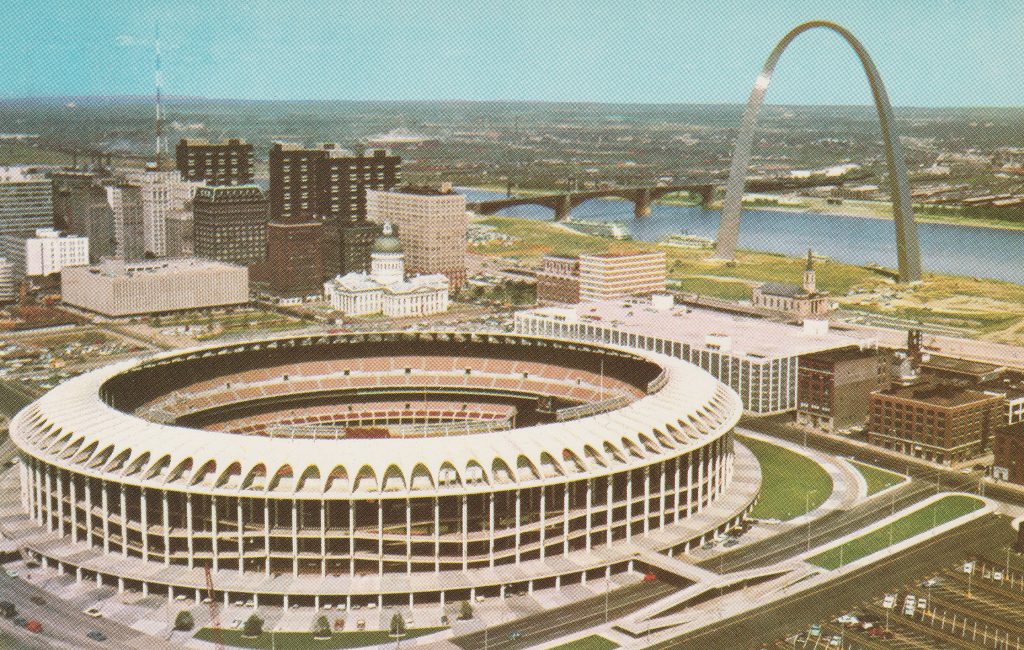
Busch Memorial Stadium in Saint Louis was home of the National League’s Cardinals from 1966 until 2005. It was also the home of the NFL Cardinals from 1966 until 1987 and the Rams for the 1995 season. The 630-foot-tall Gateway Arch, completed in 1965, towers over the stadium.
In the late 1950s, St. Louis began a redevelopment plan for a 31 square block area along the Mississippi River that contained flophouses, warehouses, and a burlesque theater. Baseball’s Cardinals needed a new ballpark, Busch Stadium (formerly known as Sportsman’s Park) was in poor condition. It lacked parking and the surrounding neighborhood had become seedy. A new ballpark was to be the centerpiece of the new district along the Mississippi River with a hotel, apartment towers, parking garages, and office buildings. In 1959, the NFL Chicago Cardinals moved to St. Louis and the stadium design was revamped to host both baseball and football.
Opening day at the new stadium, May 12, 1966, attracted 46,000 fans, the largest crowd to watch a baseball game in St. Louis since Sportsman’s Park only seated 34,000. The stadium’s roof, designed by famed architect Edward Durell Stone, incorporated 96 open arches in the roof to honor the Gateway Arch.
On July 12, 1966, Busch Memorial Stadium hosted the Major League Baseball All-Star Game. It was a humid 103-degree afternoon for the 50,000 fans. Former Yankees and Mets manager Casey Stengel stole the day when he quipped, “The new park sure holds the heat well. It took the press right out of my pants.”
Like many of the cookie-cutter stadiums hosting both baseball and football games, an AstroTurf playing field was installed in 1970, due to the damage to the playing field from football. Busch Stadium was demolished in 2005 and the Cardinals moved to the new Busch Stadium built next door.
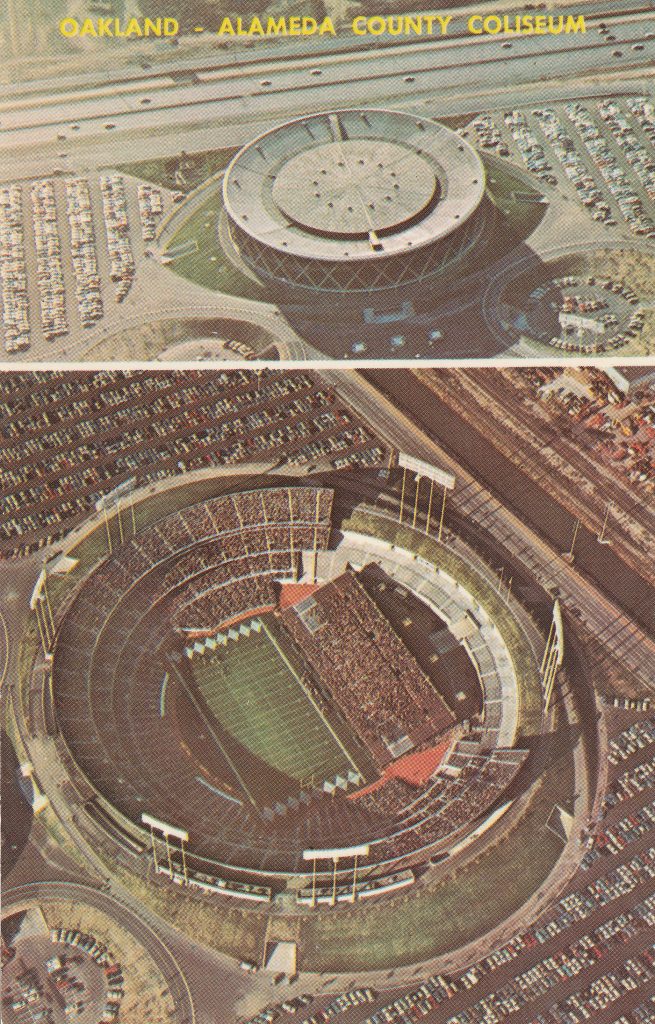
Kansas City Athletics owner Charles O. Finley received permission from the American League to relocate his team to Oakland in 1968. Renamed the Oakland A’s, the team moved into the Oakland – Alameda County Coliseum where the AFL Oakland Raiders had been playing since 1966. The Raiders played in the Coliseum until 1981when they moved to Los Angeles. They moved back in 1995 and stayed through 2019. Today, the A’s are the sole tenants. It is the only cookie – cutter stadium still in use.
The Coliseum’s playing surface is below ground level and twenty-one feet below sea level. An artificial hill surrounds the Coliseum and only the third deck is visible outside the park. There was immense criticism by baseball fans of the playing field. The Coliseum had the largest foul territory in major league baseball that enabled a large number of foul balls to be caught that ordinarily would have been out of play, giving the batter another chance. Football fans were also unhappy with the Coliseum’s original seating configuration. Many seats were far from the gridiron action.
To lure the Raiders back to Oakland from Los Angeles, the Coliseum underwent a $200 million expansion in 1995 – 1996 (the original construction cost was $25.5 million). The dilapidated stadium has been derided by sportswriters, fans, and players as the worst ballpark in the major leagues. The A’s have announced their intent to move to Las Vegas after their lease expires in 2024 and have purchased land near the strip to build a retractable roof stadium.
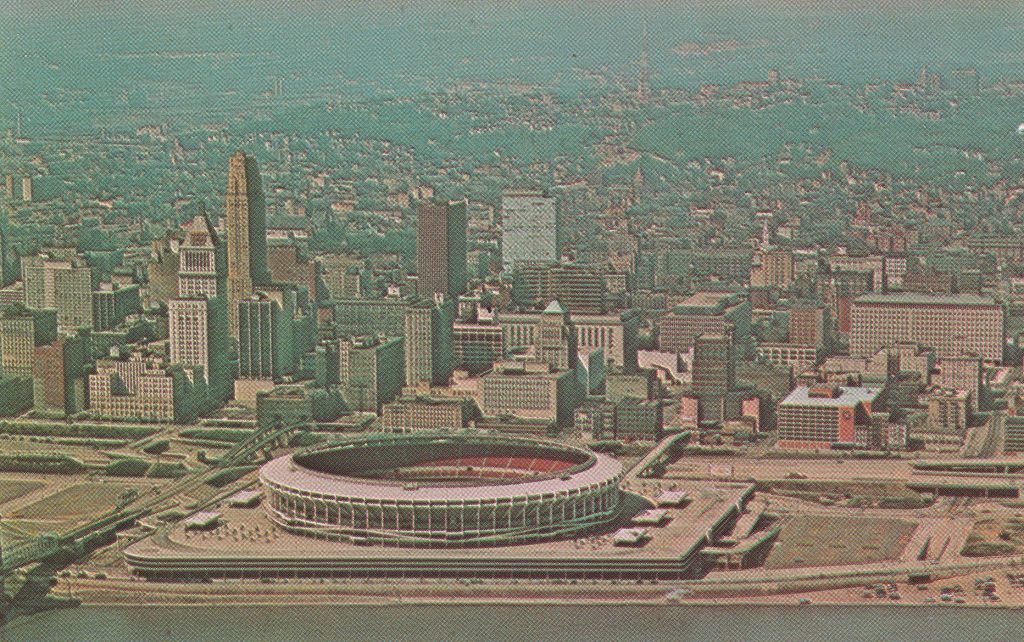
Cincinnati’s Riverfront Stadium, located on the banks of the Ohio River, opened in June 1970. It was home to the National League Cincinnati Reds from 1970 to 2002 and the National Football League Bengals from 1970 until 1999. The University of Cincinnati played 25 football games there when high profile opponents came to town from 1970 through 1990. The Reds played their first game in Riverfront on June 30, 2000, and Atlanta Braves slugger Hank Aaron hit the first homer in 1970 to christen the ballpark. The stadium hosted the All-Star game the next month. Riverfront was initially popular with Cincinnati baseball fans as the Reds won back-to-back World Series in 1975 and 1976 and pennants in 1970 and 1972 as well as National League West titles in 1973 and 1979. Reds general manager Bob Howsam and manager Sparky Anderson had taken advantage of the ballpark’s Astroturf playing surface and built the Big Red Machine around a corps of speedy hitters.
When the Bengals moved to a new football stadium in 2000, the pressure was on for a new ballpark to be built. Baseball purists waxed nostalgic for a true baseball park like the Red’s former home Crosley Field. A portion of Riverfront Stadium outfield stands were demolished to allow construction of the Great American Ballpark next door. The Reds played their final game in Riverfront on September 22, 2002.
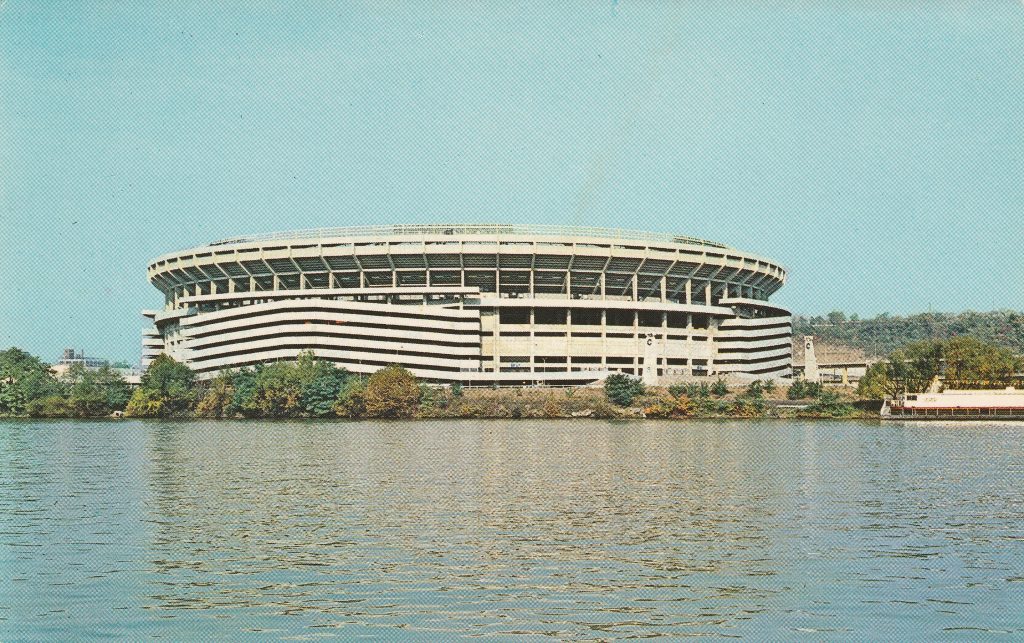
In July 1970, a month after Riverfront Stadium opened, Three Rivers Stadium opened in Pittsburgh. The stadium was built at the confluence of the Allegheny and Monongahela Rivers which form the start of the Ohio River. Three Rivers Stadium is 470 miles from Riverfront Stadium if you travel by boat on the Ohio River, but 288 miles by car via I-71 North and I-70 East. Three Rivers was the home of the National League Pittsburgh Pirates and NFL Pittsburgh Steelers from 1970 to 2000.
Planning for a new stadium began in 1958 when the Pirates sold fifty year old Forbes Field to the University of Pittsburgh that needed land for expansion. Construction did not begin until 1968. Originally a baseball stadium was to be built, but the Steelers wanted to leave Pitt Stadium where they had been playing for several years (they had played at Forbes Field from 1933 until 1963). Originally the outfield of the stadium was to be open to allow fans a view of Pittsburgh’s downtown and the Allegheny River. To provide more seating for the Steelers, the cookie cutter design was adopted, and the stadium enclosed.
Three Rivers boasted the Allegheny club, an air conditioned restaurant that accommodated 300 diners with a view of the field and 400 more in the main dining room. The Pirates winning the World Series in 1971 and 1979 plus Eastern Division first place finishes in 1970, 1972, 1974, and 1975 combined with the Steeler’s four Super Bowl victories (1974, 1975, 1978, and 1979) gave the new stadium an aura.
Three Rivers Stadium hosted the first World Series night game in 1971, and the Pirates won the series four games to three over the Baltimore Orioles. Roberto Clemente, the great Pittsburgh right fielder, hit a double on September 30, 1972, to achieve his 3,000th major hit. Three months later, Clemente died in a plane crash while delivering relief supplies to Nicaraguan earthquake victims.
Like most cookie cutter stadiums, the fans and teams soon became disenchanted. The sight lines favored football over baseball plus fans found the structure to be a soulless, concrete donut. The Steelers wanted a larger stadium after selling out every game since 1972. Plans were advanced to build new stadiums for both teams. The Pirates played their last game in Three Rivers on October 1, 2000, and moved to PNC Park for the 2001 season. The Steelers played their last game in Three Rivers on December 16, 2000, and moved to Heinz Field for the 2001 season. Three Rivers was imploded on February 11, 2001, at a cost of $5.1 million and 4,800 pounds of explosives.
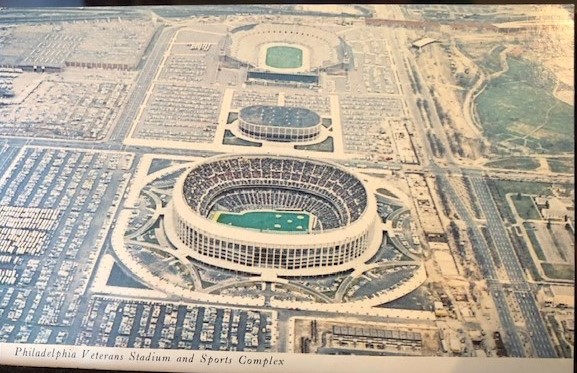
Philadelphia’s Veterans Stadium opened in April 1971. The National League Phillies moved from crumbling Connie Mack Stadium where they’d played since the 1930s. During their history, the NFL Eagles were vagabonds playing at the Baker Bowl (the Phillies original home), Connie Mack Stadium, Philadelphia Municipal Stadium, and finally the University of Pennsylvania’s Franklin Field. The Eagles would make the Vet their home until 2002.
It was also the home of the Temple University Owls football team from 1978 until 1992 as well as hosting seventeen Army – Navy football games between 1980 until 2001.
Fans were initially enchanted with the Vet. After a decade of losing seasons, the Phillies won the National League East title in 1976, 1977, and 1978 and the World Series in 1980. The Eagles had a definite home field advantage when their raucous fans took advantage of the concrete bowl to raise the noise level to prevent the opposing team from hearing signals. However, things got out of control and a municipal court judge set up shop in a makeshift courtroom during Eagles games to mete out justice to inebriated fans and fight participants.
The Vet had seven levels of seating. Baseball fans complained that binoculars were needed on the seventh level to see the play on the field. Like in other cookie cutter stadiums, baseball aficionados complained that even in the low level seats they were far from the action due to the expansive foul territory necessitated to accommodate the football field’s dimensions. As it aged, the stadium was not well maintained. During the 1998 Army – Navy game, a railing collapsed injuring eight West Point cadets. Mice infested the stadium and cats were brought in an attempt to control the vermin.
The Phillies played their last game in the Vet on September 28, 2003, and moved to Citizens Bank Park for the 2004 season. The Eagles moved to Lincoln Financial field for the 2003 season, their last game in the Vet was NFC Championship Game on January 19, 2003, losing to Tampa Bay 27 – 10. On March 21, 2004, the Vet was imploded.
Other multipurpose stadiums were the King Dome in Seattle, the Hubert H. Humphrey Metrodome in Minneapolis, the Skydome in Seattle, Olympic Stadium in Montreal, Jack Murphy Stadium in San Diego, and Tropicana Field in Saint Petersburg.
Interesting article, Shea Stadium in Flushing NY come to mind
Shea Stadium was covered in Part One. I attended a number of Mets games at Shea in the 1960’s, 1970’s and 1980’s and a few Yankees games.
SkyDome (now known as Rogers Centre) is still the Toronto Blue Jays’ home.